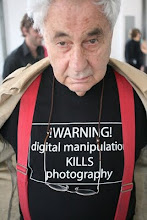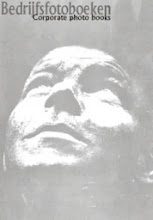 Coppens, Martien. ; Snoek, Paul. - Martien Coppens. Op de grens van land en zee. Venlo, Chemische fabriek L.van der Grinten, 1966 (?). Linnen. 46o. Met illustraties in z/w. Oplage 1500 genummerde exemplaren
Coppens, Martien. ; Snoek, Paul. - Martien Coppens. Op de grens van land en zee. Venlo, Chemische fabriek L.van der Grinten, 1966 (?). Linnen. 46o. Met illustraties in z/w. Oplage 1500 genummerde exemplaren Martien Coppens was born in 1908, son of a clog maker from Lieshout, a village a stone's throw from the town of Eindhoven. Very soon he developed a remarkable interest for photography (on one of his school reports it is mentioned that the photography could actually use a bit less attention) and follows, exceptionally, an education abroad, in Munich. After some wandering, he establishes himself as independent photographer in Eindhoven. He works on request, but has a preference for free work and for what he callls artistic photography. His photos are authentic and realistic, although the quality of his work was not appreciated by all people at that time. Martien Coppens focused his camera quite often at Brabant farmers and workers, at church buildings, and at landscapes, such as De Peel, but he was also interested in the dynamics of a city such as Eindhoven and her industrial activity. He was an enterprising man who published about seventy photo books, of which some were well accepted by the public.
Martien Coppens was born in 1908, son of a clog maker from Lieshout, a village a stone's throw from the town of Eindhoven. Very soon he developed a remarkable interest for photography (on one of his school reports it is mentioned that the photography could actually use a bit less attention) and follows, exceptionally, an education abroad, in Munich. After some wandering, he establishes himself as independent photographer in Eindhoven. He works on request, but has a preference for free work and for what he callls artistic photography. His photos are authentic and realistic, although the quality of his work was not appreciated by all people at that time. Martien Coppens focused his camera quite often at Brabant farmers and workers, at church buildings, and at landscapes, such as De Peel, but he was also interested in the dynamics of a city such as Eindhoven and her industrial activity. He was an enterprising man who published about seventy photo books, of which some were well accepted by the public.Martin Parr and Gerry Badger : The Photobook: A History volume 1/ Memory and Reconstruction : The Postwar European Photobook
Martien Coppens was responsible for a number of topographical photobooks during the 1930s and 1940s, documenting the architecture, landscape and art of his native Brabant. These were in a similar vein to the Publishing house Contact's De Schoonheid van ons Land (Our beatiful Country), showing a comparable focus on the cultural heritage of Holland. As the title of Contact's series implies, the kind of photography employed was traditional, large-format, topographically precise, with an emphasis on the picturesque, on heritage and continuity rather than change.It was this kind of rhetoric that was employed by Coppens for his 1947 book Impressies 1945 (Impressions 1945), but his subject was radically different. He still concentrated on the Dutch landscape and architectural heritage, and photographed it in his usual romantic style, but now his theme was the Dutch heritage interrupted by the discontinuities and disruption of war. He chose the lighting carefully, often a combination of sun and cloud that would allow him to set a ruin picked out by sunlight against a glowering, cloudy sky. Add luscious gravure printing, and Coppens's ruins look less like real buildings than stage sets. In all of his work, and in this book in particular, Coppens opposed the prevailing trend in Dutch photography of the time, which was progressing towards a gritty, Existensial realism, and he was criticized for it by other photographers.Coppens, who habitually dealt in nostalgia, photographed this devastated landscape in the only way he knew, even exaggerating the romantic rhetoric of the ruin. But like Jean Cocteau and Pierre Jahan in La Mort et la statues, Coppens demonstrated that there were many different ways in which artists and photographers could come to terms with what had happened to Europe.














Geen opmerkingen:
Een reactie posten